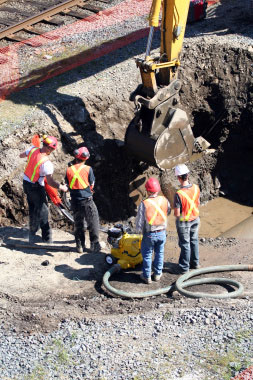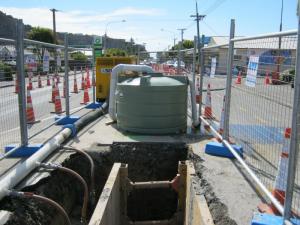Dewatering
If in doubt – Stop and Shout! Take the time to plan and use the right dewatering system and ensure the sediment/silt is removed before entering storm water*, streams or rivers.
Dewatering refers to pumping water out of a hole or excavation.
Dewatering can be done in one of three ways: wellpointing,
utilising an existing bore or direct pumping.
Wellpointing
This involves installing a number of small perforated pipes around the area to be excavated and to a depth greater than the intended base of the excavation. Usually the pipes are connected to a larger pipe and water is pumped out to lower the groundwater level around the excavation area.-
Existing bore
This is used in a similar manner to wellpointing, except the bore is already established and the water should run very cleanly from the start. However, the bore must be close to the proposed excavation area and be a similar depth in order for the bore to be of any use. -
Direct pumping
This involves placing a pump in the base of the hole or excavation area and pumping the water out. This is an inexpensive and efficient method of pumping water from a hole. The pumped water is usually very dirty and needs to be carefully treated to remove the dirt before it reaches the stormwater kerb and channel or a waterway.
Water from a wellpointing system usually runs cleanly after an initial burst of dirty water at the start and is best used where groundwater is high. However, it is not the best method for stormwater or a burst pipe. Wellpointing requires planning and may require a specialised contractor to carry out the work.
*You need permission from the local council controlling the stormwater system BEFORE you discharge into it.
*You may also need a consent
from Environment Canterbury.
Contact customer services on
0800 EC INFO (324 636).




